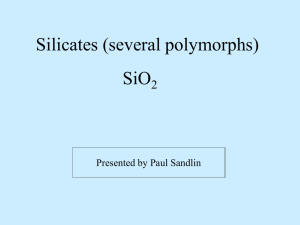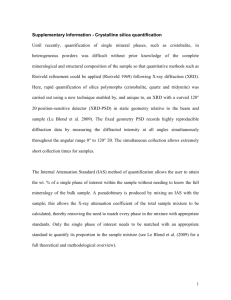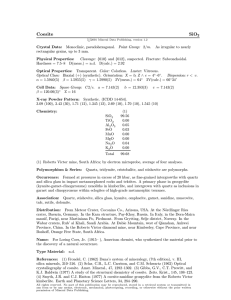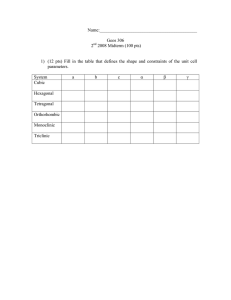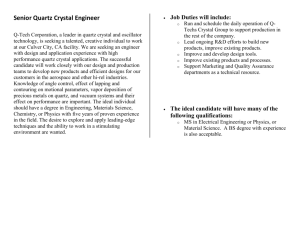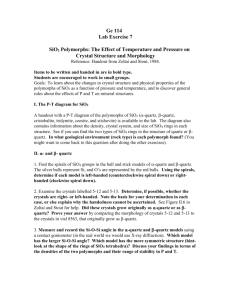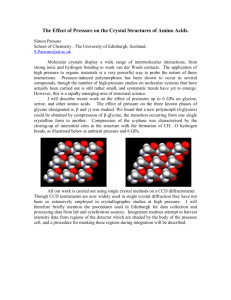a R. T.
advertisement
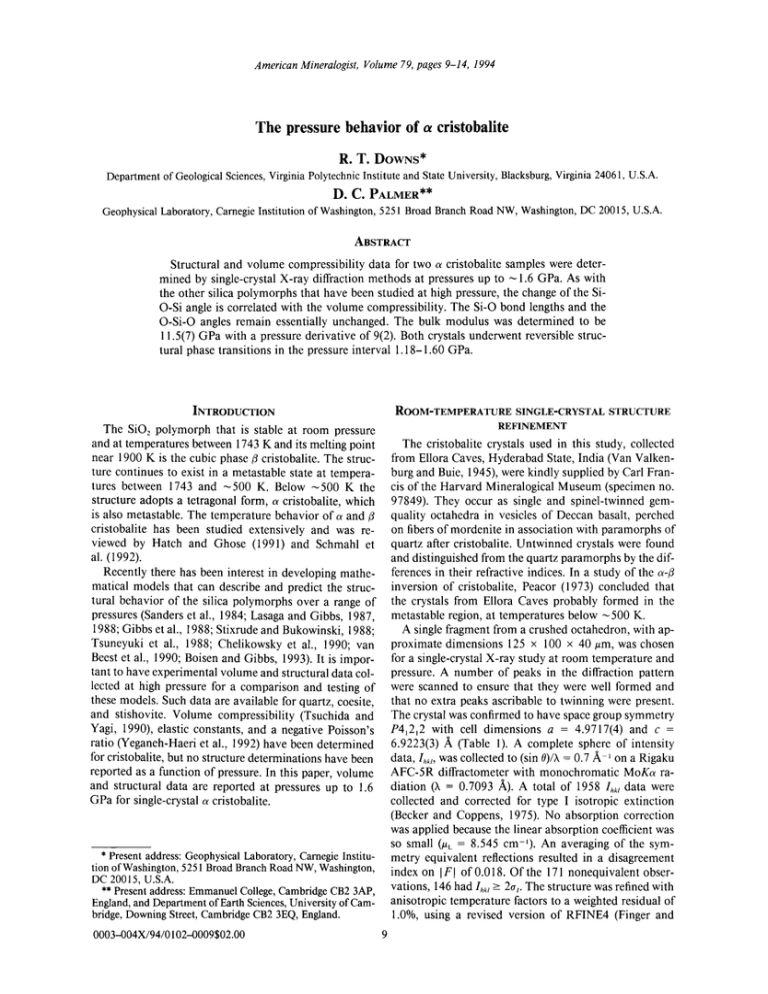
American
Mineralogist,
Volume 79, pages 9-14. 1994
The pressure behavior of a cristobalite
R. T. DOWNS*
Department
of Geological Sciences, Virginia Polytechnic Institute and State University,
Blacksburg, Virginia 24061, U.S.A.
D. C. PALMER**
Geophysical
Laboratory,
Carnegie Institution
of Washington,
5251 Broad Branch Road NW, Washington,
DC 20015, U.S.A.
ABSTRACT
Structural and volume compressibility data for two a cristobalite samples were determined by single-crystal X-ray diffraction methods at pressures up to -1.6 GPa. As with
the other silica polymorphs that have been studied at high pressure, the change of the SiO-Si angle is correlated with the volume compressibility. The Si-O bond lengths and the
O-Si-O angles remain essentially unchanged. The bulk modulus was determined to be
11.5(7) GPa with a pressure derivative of 9(2). Both crystals underwent reversible structural phase transitions in the pressure interval 1.18-1.60 GPa.
INTRODUCTION
The Si02 polymorph that is stable at room pressure
and at temperatures between 1743 K and its melting point
near 1900 K is the cubic phase (3cristobalite. The structure continues to exist in a metastable state at temperatures between 1743 and -500 K. Below -500 K the
structure adopts a tetragonal form, a cristobalite, which
is also metastable. The temperature behavior of a and (3
cristobalite has been studied extensively and was reviewed by Hatch and Ghose (1991) and Schmahl et
al. (1992).
Recently there has been interest in developing mathematical models that can describe and predict the structural behavior of the silica polymorphs over a range of
pressures (Sanders et aI., 1984; Lasaga and Gibbs, 1987,
1988; Gibbs et aI., 1988; Stixrude and Bukowinski, 1988;
Tsuneyuki et aI., 1988; Chelikowsky et aI., 1990; van
Beest et aI., 1990; Boisen and Gibbs, 1993). It is important to have experimental volume and structural data collected at high pressure for a comparison and testing of
these models. Such data are available for quartz, coesite,
and stishovite. Volume compressibility (Tsuchida and
Yagi, 1990), elastic constants, and a negative Poisson's
ratio (Yeganeh-Haeri et aI., 1992) have been determined
for cristobalite, but no structure determinations have been
reported as a function of pressure. In this paper, volume
and structural data are reported at pressures up to 1.6
GPa for single-crystal a cristobalite.
ROOM-TEMPERA
I 02--0009$02.00
SINGLE-CRYSTAL
STRUCTURE
REFINEMENT
The cristobalite crystals used in this study, collected
from Ellora Caves, Hyderabad State, India (Van Valkenburg and Buie, 1945), were kindly supplied by Carl Francis of the Harvard Mineralogical Museum (specimen no.
97849). They occur as single and spinel-twinned gemquality octahedra in vesicles of Deccan basalt, perched
on fibers of mordenite in association with paramorphs of
quartz after cristobalite. Untwinned crystals were found
and distinguished from the quartz paramorphs by the differences in their refractive indices. In a study of the a-(3
inversion of cristobalite, Peacor (1973) concluded that
the crystals from Ellora Caves probably formed in the
metastable region, at temperatures below
500 K.
A single fragment from a crushed octahedron, with approximate dimensions 125 x 100 x 40 Jim, was chosen
for a single-crystal X-ray study at room temperature and
pressure. A number of peaks in the diffraction pattern
were scanned to ensure that they were well formed and
that no extra peaks ascribable to twinning were present.
The crystal was confirmed to have space group symmetry
P41212 with cell dimensions a = 4.9717(4) and c =
6.9223(3) A (Table I). A complete sphere of intensity
-
data,
hkh
was collected to (sin IJ)/A= 0.7 A-Ion a Rigaku
AFC-5R diffractometer with monochromatic MoKa radiation (A = 0.7093 A). A total of 1958 Ihk, data were
collected and corrected for type I isotropic extinction
(Becker and Coppens, 1975). No absorption correction
was applied because the linear absorption coefficient was
so small (JiL = 8.545 cm-I). An averaging of the symmetry equivalent reflections resulted in a disagreement
index on IFI of 0.0 18. Of the 171 nonequivalent observations, 146 had Ihk,:o::2(1/.The structure was refined with
anisotropic temperature factors to a weighted residual of
1.0%, using a revised version of RFINE4 (Finger and
* Present address: Geophysical Laboratory, Carnegie Institution of Washington, 5251 Broad Branch Road NW, Washington,
DC 20015, U.S.A.
Present address: Emmanuel College, Cambridge CB2 3AP,
**
England,
and Department of Earth Sciences, University ofCambridge, Downing Street, Cambridge CB2 3EQ, England.
0003--004X/94/0
TURE
9
DOWNS
10
TABLE 1.
Cell parameters
sure
P
(GPa)
AND
for cristobalite
PALMER:
as a function
c
a
(A)
4.9717(4)
4.9501(6)
4.9304(8)
4.9028(8)
4.8757(8)
4.8662(8)
4.8535(8)
4.834(6)
0.0
0.08(3)
0.15(9)
0.15(8)
0.25(8)
0.35(8)
0.77(8)
0.81(8)
0.29(6)
0.30(7)
0.31(6)
0.55(6)
0.52(3)
1.06(4)
1.26(3)
0.09(4)
0.79(2)
1.18(3)
4.975(1 )
4.9662(8)
4.9608(9)
4.9568(9)
4.9482(9)
4.9404(8)
4.898(1 )
4.902(1 )
4.9384(8)
4.939(1)
4.940(1)
4.917(1)
4.9136(9)
4.875(1)
4.870(1)
4.9620(8)
4.895(1)
4.865(7)
of pres-
V
(A')
(A)
0.0
0.19(3)
0.30(3)
0.73(3)
1.05(4)
1.30(3)
1.50(4)
1.60(4)
PRESSURE
Crystal
1
6.9223(3)
6.8760(6)
6.8343(8)
6.7782(9)
6.7163(8)
6.6979(7)
6.6733(8)
6.642(2)
171.10(1)'
168.48(4)'
166.13(5)
162.93(6)'
159.66(6)'
158.61(5)
157.20(5)
155.2(4)"
BEHAVIOR
TABLE3.
OF a CRISTOBALITE
Selected interatomic distances (A) and angles (0) for
cristobalite as a function of pressure
P(GPa)
0.0001
0.19
0.73
1.05
R(Si-O) x 2
R(Si-O) x 2
Si-O-Si
O-Si-O x 2
O-Si-O
O-Si-O x 2
O-Si-O
1.603(1)
1.603(1)
146.49(6)
108.20(2)
109.03(9)
109.99(7)
111 .42(8)
1.598(5)
1.608(4)
145.1(2)
108.2(1)
109.3(3)
109.8(3)
111.6(3)
1.600(6)
1.609(5)
142.1(3)
108.0(1)
109.6(4)
109.9(3)
111.6(4)
1.602(8)
1.610(6)
140.4(4)
107.8(2)
110.0(5)
109.8(4)
111.6(5)
Note: the room-pressure
Si-O bond lengths,
motion (Downs et al., 1992) are 1.611(1) A.
corrected
for rigid body
Crystal 2
6.9259(8)
6.9087(9)
6.900(1)
6.890(1 )
6.873(1 )
6.8557(9)
6.768(1)
6.774(1 )
6.8567(9)
6.859(1 )
6.854(1 )
6.808(1)
6.8019(9)
6.725(1)
6.709(1)
6.8951(9)
6.760(1)
6.724(7)
171.42(9)
170.39(5)
169.81(6)
169.28(6)
168.27(6)
167.33(6)
162.37(6)
162.78(7)
167.22(5)
167.31(6)
167.26(7)
164.60(6)
164.22(6)
159.82(7)
159.12(7)"
169.77(6)
161.98(7)
159.1 (4)"
Note: the data are presented in the order in which they were collected.
The, pressure was adjusted up and down several times for crystal 2.
Intensity data were collected for these experiments.
The crystals transformed
to a new phase during these experiments.
..
Prince, 1975). The refined structural parameters and the
conditions of refinement are given in Table 2, selected
interatomic distances and angles are given in Table 3, and
observed and calculated structure factors are listed in Table 4.1 Additional refinements were undertaken with one
I
To obtain a copy of Table 4, order Document AM-94-544
from the Business Office, Mineralogical
Society of America, 1130
Seventeenth Street NW, Suite 330, Washington,
DC 20036,
U.S.A. Please remit $5.00 in advance for the microfiche.
TABLE2.
Intensity collection and refinement results for cristobalite as a function of pressure
P(GPa)
No. obs. I > 2er,
p'
Weighted R
Unweighted R
u"
B(Si)
x
Y
z
B(O)
..'Weights
0.0001
0.19
0.73
1.05
146
0.0
0.010
0.029
0.30028(9)
0.765(7)t
0.2392(2)
0.1044(2)
0.1787(1)
1.48(3)t
106
0.025
0.040
0.053
0.3027(4)
0.80(4)
0.2388(8)
0.1086(9)
0.1817(5)
1.22(9)
105
0.04
0.055
0.056
0.3086(4)
0.63(5)
0.2364(10)
0.1198(11)
0.1870(6)
1.07(9)
102
0.06
0.074
0.065
0.3125(5)
0.51(7)
0.2356(15)
0.1269(15)
0.1904(8)
1.12(12)
were computed by er
~
The Si atom is located at Wyckoff
Veri + p'F'.
position 4a, with coordinates
[uuO].
t Values for B(Si) and B(O) at room pressure represent isotropic equivalents of the anisotropic temperature
factors given by exp{ -'J:;T,h,h,i3,,},
i313 =
i312 = -0.0003(2),
i333 = 0.00401(9),
where i3" = i322 = 0.0077(1),
)
for Si and i3" = 0.0244(7), i322= 0.0086(5), i333= 0.0062(2),
-i323 ~ 0.0008(1
~
0.0005(3)
for
O.
i323
i313 ~ 0.0027(3),
i312 ~ -0.0013(4),
and two twin components, according to the twin laws
suggested by Dollase (1965). Twin components, if present
at all, appear to be < 1%.
The structure of a a cristobalite consists of a framework
of corner-sharing Si04 tetrahedra, each with two nonequivalent SiO bond lengths of 1.603 A, linked together
with Si-O-Si angles of 146.49°. Despite equal bond lengths,
the Si04 tetrahedra are more distorted than those in either quartz or coesite, two other well-ordered structure
types of silica. The O-Si-O angles of the tetrahedra vary
between 108.2 and 111.4°, with a tetrahedral angle variance of 1.56°, compared with 0.2 and 0.8° for quartz and
coesite. Since all Si-O bonds are equal in length, it is not
apparent why the O-Si-O angles depart from cos
- V3,
given the correlations generally found between the fractional s character of tetrahedral oxyanions, };(T), and bond
length (Boisen and Gibbs, 1987; Boisen et aI., 1990). Selected interatomic angles and bond lengths (Table 3) are
in reasonable agreement with the values reported by Dollase (1965), Peacor (1973), and Pluth et al. (1985).
The thermal parameters obtained for the Si and 0 atoms in all the single-crystal structural studies of a cristobalite, induding this one, are large compared with those
for quartz or coesite. This has been a matter of concern
in previous investigations (Nieuwenkamp, 1937; Dollase,
1965; Peacor, 1973) because large temperature factors are
often a sensitive indicator of a twinned or disordered
structure, or they can result from significant parameter
correlations in the refinement.
In our study, the largest parameter correlation (0.46)
was between the scale factor and {311 for the Si atom. As
the remaining correlations are significantly smaller than
0.46, it appears that problems with correlation are minimal. An examination of the orientations of the thermal
ellipsoids shows that the major axis of the 0 atom is
normal to the Si-O-Si plane to within SO,consistent with
Peacor's (1973) observation. Furthermore, the differences
in the mean-square displacements of the Si and 0 atoms
along the Si-O bonds and between the intra tetrahedral 0
atoms are small enough to indicate that the Si04 tetrahedra behave essentially as rigid bodies (Downs et aI.,
1990), and therefore the thermal parameters do not contain a significant component of static disorder. Finally, a
plot of the average amplitudes of the root-mean square
displacements, (ub)"'. recorded for the 0 atoms in cris-
DOWNS AND PALMER: PRESSURE
BEHAVIOR
----
1.00
0.15
cristobolite
0.14
- - - ----- _ ;tish~vite
,
- -,
",
0.98
"
........... 0.13
o<r:
..........
t\I
"""....
~o
II
OF exCRISTOBALITE
0.12
o
,~~e:i~e
quartz-
0.96
:>
............
0.11
:>
;:j
0.94
0.10
0.92
0.09
0.08
2.2
2.4
density
2.6
2.8
3.0
0.90
(gm/ cm3)
Fig. I This plot demonstrates that the average amplitudes of
the root-mean square displacements of 0, (Ub>\ are negatively
correlated with the density of cristobalite, quartz (Kihara, 1990),
and coesite (Geisinger et a!., 1987). A similar relation holds for
the Si atoms, since the ratio of the displacements of 0 and Si
are relatively constant for the silica polymorphs.
tobalite, quartz, and coesite, shows that (Ub)'h is negatively correlated with density (Fig. 1). It follows that, although the shapes and orientations
of the thermal
ellipsoids are consistent with relatively large Si-O stretching and O-Si-O angle bending force constants and a relatively small Si04 librational force constant, the size of
the thermal ellipsoids seems to depend, in part, on the
packing density of the tetrahedra.
HIGH-PRESSURE CELL REFINEMENTS
The crystal for which room-pressure data were recorded was transferred to a miniature diamond-anvil
cell
(modified after Merrill and Bassett, 1974) with a 4:1
methanol to ethanol mixture used as a pressure medium.
The crystallographic cell dimensions at each pressure were
refined from reflections in the range 30° s 2() s 52° that
were recorded with the eight-reflection centering technique (King and Finger, 1979) on an automated Picker
four-circle diffractometer using MoKa radiation. The
pressure was determined by fitting Lorentzian functions
to the fluorescence spectra of several small ruby chips
included in the diamond-anvil cell. From the least-squares
estimates of the ruby R, and R2 peak positions, the pressure of the experiment was determined using the relationship established by Mao et al. (1978). With this technique, the pressure was determined with a precision better
than 0.1 GPa. Diffraction data were recorded at seven
pressures up to 1.60(4) GPa, where the crystal transformed into a new, higher pressure structure type, a transformation that was first reported by Yeganeh-Haeri et al.
(1990) as occurring around I GPa. A least-squares refinement of these data gave the cell dimensions in Table
0.5
0.0
Pressure
1.0
1.5
(OPa)
Fig. 2. The unit-cell volume of excristobalite as a function of
pressure. The solid and open circles represent data from crystal
I and crystal 2, respectively, with the errors in pressure being
indicated. The best fit Birch-Murnaghan equation of state [K() =
11.5(7) GPa, K~ = 9(2)] is represented as the solid curve. For
comparison, the pressure-volume curves for quartz, coesite, and
stishovite are presented as dashed lines. This plot indicates that
cristobalite is the most compressible of these Si02 polymorphs.
1. The transformation occurred during data collection,
several hours after the pressure of 1.60 GPa was obtained,
and took
-
20 min to complete,
which
was cal-
culated based on the rate of diminution of the intensities
being collected. Unfortunately, the crystal was lost when
it was transferred to the Rigaku diffractometer for a study
of its peak shapes.
A second crystal was selected, and diffraction data were
recorded at 18 pressures according to the sequence given
in Table I. During this sequence of experiments, the pressure was adjusted up and down several times. At 1.26(3)
GPa, the crystal transformed to the high-pressure phase,
but it transformed back to a cristobalite when the pressure was lowered. When the pressure was increased once
again, the crystal transformed to the high-pressure structure type, but at a slightly lower pressure [1.18(3) GPa].
As with the first crystal, cell dimensions were refined with
the data recorded at the pressures indicated in Table I.
The structure of the high-pressure phase is currently being studied, and its Raman spectra are being characterized (Palmer and Finger, 1994).
The un weighted volume, VI Va, and pressure data recorded for the two crystals (Table I) were fitted to a thirdorder Birch-Murnaghan equation of state following the
strategies outlined in Bass et al. (1981). The fit yields a
zero pressure bulk modulus, Ko = 11.5(7) GPa, with its
pressure derivative, K~ = 9(2). The volume compressibility curve obtained in the analysis is displayed in Figure 2, along with the data recorded for the two crystals.
DOWNS AND PALMER: PRESSURE
12
BEHAVIOR
OF
C/
CRISTOBALITE
or less parallels that at high pressure. This could indicate
that the compression and expansion mechanisms are the
same for cristobalite. It will be shown later that these
results are consistent with tilting of the SiO. tetrahedra
and concomitant Si-O-Si angle bending.
1.01
1.00
0.99
HIGH-PRESSURE
0
C)
0.98
"'"
C)
0.97
0.96
0.95
1.01
1.00
0.99
0.98
0.97
0.96
0.95
a/ao
Fig. 3. The variation of clco vs. a/aD for C/cristobalite with
data recorded at high temperature (+) (Schmahl et aI., 1992) and
high pressure (solid circles for crystal I and open circles for crystal 2). The asterisk represents the last data point for crystal 2 in
Table I where the crystal underwent a phase transition during
the data collection and may be considered an outlier. This plot
shows that the relative effects of compression on a/ao and clco
remain constant over the pressure interval, with clco being 1.50(1)
times more compressible than a/ao' Furthermore, the similarity
in the slopes of the compression and thermal expansion data
appear to indicate that the mechanism for cell-edge variations
at high temperature or at high pressure are the same.
The bulk modulus obtained in our analysis is smaller
than that determined in a recent Brillouin spectroscopic
study (16.4 GPa: Yeganeh-Haeri et aI., 1992) and that
reported by Tsuchida and Yagi (1990) (18 GPa) obtained
through an X-ray diffraction study ofa powdered sample
without using a hydrostatic medium in their high-pressure cell. This latter study indicated that cristobalite
transformed to a new structure at a pressure > 10 GPa,
somewhat less than that predicted by the molecular dynamics calculation of Tsuneyuki et al. (1989) (16.5 GPa).
It appears that the transformation pressure obtained by
Tsuchida and Yagi (1990) defined a transition to a phase
different from the one reported here.
Figure 2 shows that a cristobalite is much more compressible than either a quartz (Ko = 41.4 GPa, K~ = 4:
Glinnemann et aI., 1992), coesite (Ko = 95.4 GPa, K~ =
8.6: Levien and Prewitt, 1981), or stishovite (Ko = 312.2
GPa, K~ = 1.8: Ross et aI., 1990). The K~ values obtained
for these crystals range from 1.8 for stishovite to 9.0 for
cristobalite, with very high uncertainties and no apparent trends.
Figure 3 shows that c!co compresses 1.50(1) times more
than a/aD. Data recorded for a cristobalite at high temperatures (Schmahl et aI., 1992) are also plotted for comparison, and it appears that the trend for these data more
STRUCTURE
REFINEMENTS
Intensity data from the first crystal were recorded for
refinements of the structure up to (sin 8)/A = 0.7 A -I at
pressures of 0.19, 0.73 and 1.05 GPa on the automated
Picker four-circle diffractometer with MoKa radiation. A
summary of the intensity collection procedures and refinement results is provided in Table 2. In particular, the
value of the parameter, p, which is used to calculate the
regression weights (0"= Y0"7 + p2P), was assigned a value
that constrained the calculated errors in the diffracted
intensities to be distributed normally through a probability plot analysis, according to the strategies of Abrahams and Keve (1971). All parameters varied smoothly
with pressure, except for the isotropic temperature factor
of the 0 atom.
Attempts to refine anisotropic thermal parameters re-
sulted in values of {3ij that did not indicate the expected
rigid body behavior of the SiO. tetrahedra. It was concluded that the anisotropic thermal parameters obtained
at high pressure did not provide a meaningful measure
of the thermal motion, and so the refinement was completed with an isotropic thermal parameter model. Selected bond lengths and angles are found in Table 3, and
observed and calculated structure factors are on deposit
in Table 4.
STRUCTURAL VARIATIONS WITH PRESSURE
With increasing pressure, the SiO. tetrahedron in a
cristobalite undergoes only a slight distortion. The Si-O
bond lengths remain statistically unchanged, whereas two
of the O-Si-O angles show small deviations from values
observed at room pressure. The O-Si-O angle that lies
more or less parallel to the c axis is found to decrease by
0.4°, whereas the one that lies more or less in the ab plane
increases by 1°. The 0 atom shifts along the same vector
observed by Peacor (1973) in his high-temperature study,
but in the opposite direction. Over the 1.05-GPa pressure
range that results in a 4.50 tilt of the SiO. group about
the twofold axis ( 110) directions) that passes through
the Si atom. Rotations of the SiO. tetrahedra about these
directions have also been shown to be responsible for the
strong diffuse scattering observed by electron diffraction
of {3cristobalite at high temperatures (Hua et aI., 1988).
Concomitant with tilting, the Si-O-Si angle decreases
by 60 over the 1.05-GPa pressure range. This is a significantly greater angular change than that observed for either quartz or coesite over the same pressure range. To
appreciate the relative angular change for the three polymorphs, the normalized Si-O-Si angle, c/J= (Si-O-Si)/ (SiO-Si)o, was plotted as a function of pressure (Fig. 4a),
where (Si-O-Si) is the average Si-O-Si angle at pressure
DOWNS AND PALMER: PRESSURE
and (Si-O-Si)o is the average angle at room pressure. The
trends of tjJ with pressure for the three polymorphs resemble that between VI Vo and pressure (Fig. 2). When tjJis
plotted against VI Vo for all three polymorphs, the data
fall along a single trend (Fig. 4b) rather than the three
distinct trends displayed in Figures 2 and 4a. The solid
line drawn through the data in Figure 4b was calculated
for both
IX
quartz and
IX
cristobalite, using the SQLOO
covalent energy function of Boisen and Gibbs (1993). This
function includes terms for Si-O bond stretching, O-Si-O
and Si-O-Si angle bending and non-codimer 00 repulsion forces obtained from molecular orbital calculations
on silicate fragments. The modeled curves for quartz and
cristobalite are virtually identical, therefore they are superimposed in the figure as a single line; they do not
represent curves fitted to the data. The fact that tjJ and
VI Va are linearly correlated is not surprising in light of
the correlations presented in Figures 2 and 4a. However,
that tjJvs. VI Vo data for all three polymorphs fall along a
single straight line was unexpected. This result implies
that the compressibility of these silica polymorphs is controlled in the same manner, by the bending of the Si-OSi angles and a consequent shortening of the Si-Si distances only. The SQLOO calculations indicate that the
change in energy for a given change in volume is larger
for quartz than for cristobalite. This is in agreement with
the greater compressibility of cristobalite. However, the
calculations also indicate that the contribution to the total energy change ascribed to the Si-O-Si bending terms
is the same in both structures. That can explain why the
calculated curves for both quartz and cristobalite are superimposed in Figure 4b. Since the theoretical data fall
along the same trend as the observed data, it appears that
the SQLOO model may provide an explanation of the
trend. Although no experimental data are available yet
for the SiO, glasses, also plotted in Figure 4b is a curve
fitted to model calculations of the structure ofl4JSi02 glass
(Stixrude and Bukowinski, 1991). The figure shows that
for a given change in volume (or density) the Si-O-Si
angle in glass is not compressed as much as in the crystalline silica polymorphs. Stixrude and Bukowinski (1991)
ascribed this different behavior to the torsional degrees
of freedom in Si02 glass.
The tilting of rigid polyhedra has been shown to be a
common characteristic of many structures at high pressure (Hazen and Finger, 1979; Dove et aI., 1993) and can
be used to describe their structural changes and phase
transitions. This appears to be true for cristobalite as well,
where the tilting of the Si04 tetrahedra is concomitant
with bending of the Si-O-Si angle. With an increase in
pressure, both the tilting and Si-O-Si angie bending promote the shortening of the c cell edge. On the other hand,
although the bending of the Si-O-Si angle promotes shortening of the a cell edge, the tilting of the Si04 tetrahedron
opposes it. This observation qualitatively explains why
the compression of clco is greater than that for alao (Fig.
3) and may also suggest a mechanism for the negative
Poisson's ratio observed by Yeganeh-Haeri et al. (1992).
BEHAVIOR
OF a CRISTOBALITE
13
a
1.00
o
./"'--.
.r-!
ill
0.98
a.r-!
ill 0.96
...............
'"
-:::- 0.94
ill
a.
r-! 0.92
ill
...............
0.90
a
246
8
10
(CPa)
Pressure
b
o 1.00
...............
.r-!
ill
.o
0.98
r-!
ill
0.96
~
...............
ill 0.94
o.
0.92
r-!
ill
...............
0.90
1.00
0.95
0.90
0.85
0.80
VIVo
Fig. 4. (a) A plot of pressure vs. the normalized average SiO-Si angles for cristobalite, quartz (Levien et aI., 1980; Glinnemann et aI., 1992), and coesite (Levien and Prewitt, 1981). The
zero-pressure compression rates of the normalized angles are
-0.039(1) GPa-1 for cristobalite, -0.0133(4) GPa-1 for quartz,
and -0.0050(1) GPa-1 for coesite. This plot indicates that the
Si-O-Si angle is most compressible in cristobalite. (b) A plot of
the normalized unit-cell volume, VIVo, vs. the normalized average Si-O-Si angle observed for cristobalite, quartz, and coesite.
The symbols are the same as in a. Superimposed on the plot is
a line representing the modeled variations for both cristobalite
and quartz. The dashed curve represents a fit to modeled SiO,
glass (Stixrude and Bukowinski, 1991). A linear regression of the
cristobalite, quartz, and coesite data gives (Si-O-Si)1 (Si-O-Si)a =
0.390(5) + 0.610(5) VI Va. From this equation we can calculate
a Si-O-Si angle of 138.2° at a transition pressure of 1.6 GPa. In
surprising contrast to a, this plot shows that the normalized SiO-Si angle varies with volume in the same manner for these
crystalline silica polymorphs.
14
DOWNS AND PALMER: PRESSURE
ACKNOWLEDGMENTS
The experimental work reported here could not have been carried out
without the kind patronage of Charlie Prewitt, a predoctoral fellowship
for R.T.D., and postdoctoral fellowship for D.C.P. Especially acknowledged are the supervision and tutelage of Bob Hazen and Larry Finger.
G.V. Gibbs and M.S.T. Bukowinski made major contributions to the
manuscript. Ross Angel, M. Mellini, and an anonymous reviewer are
thanked for their constructive reviews. The authors would like to thank
the National Science Foundation for its generous support through grant
EAR-93-03589.
REFERENCES
CITED
Abrahams, S.c., and Keve, E.T. (1971) Normal probability plot analysis
of error in measured and derived quantities and standard deviations.
Acta Crystallographica, A27, 157-165.
Bass, J.D., Liebermann, R.C., Weidner, DJ., and Finch, SJ. (1981) Elastic properties from acoustic and volume compression experiments.
Physics of the Earth and Planetary Interiors, 25, 140-158.
Becker, PJ., and Coppens, P. (1975) Extinction within the limit of validity of the Darwin transfer equations. III. Non-spherical crystals and
anisotropy of extinction. Acta Crystallographica, A31, 417-425.
Boisen, M.B., Jr., and Gibbs, G.V. (1987) A method for calculating fractional s-character for bonds of tetrahedral oxyanions in crystals. Physics and Chemistry of Minerals, 14,373-376.
(1993) A modelling of the structure and compressibility of quartz
with a molecular potential and its transferability to cristobalite and
coesite. Physics and Chemistry of Minerals, 20, 123-135.
Boisen, M.B., Jr., Gibbs, G.V., Downs, R.T., and D'Arco, P. (1990) The
dependence of the SiO bond length on structural parameters in coesite,
the silica polymorphs, and the clathrasils. American Mineralogist, 75,
748-754.
Chelikowsky, J.R., King, H.E., Jr., Troullier, N., Martins, J.L., and Glinnemann, J. (1990) Structural properties of a-quartz near the amorphous
transition. Physical Review Letters, 65, 3309-3312.
Dollase, W.A. (1965) Reinvestigation of the structure of low cristobalite.
Zeitschrift fUr Kristallographie, 121,369-377.
Dove, M.T., Giddy, A.P., and Heine, V. (1993) Rigid unit mode model
of displacive phase transitions in framework silicates. Transactions of
the American Crystallographic Association, 27, 65-75.
Downs, R.T., Gibbs, G.V., and Boisen, M.B., Jr. (1990) A study of the
mean-square displacement amplitudes ofSi, AI, and 0 atoms in framework structures: Evidence for rigid bonds, order, twinning, and stacking
faults. American Mineralogist, 75, 1253-1267.
Downs, R.T., Gibbs, G.V., Bartelmehs, K.L., and Boisen, M.B., Jr. (1992)
Variations of bond lengths and volumes of silicate tetrahedra with temperature. American Mineralogist, 77, 751-757.
Finger, L.W., and Prince, E. (1975) A system of Fortran IV computer
programs for crystal structure computations. U.S. National Bureau of
Standards, Technical Note, 854, 128 p.
Geisinger, K.L., Spackman, M.A., and Gibbs, G.V. (1987) Exploration of
structure, electron density distribution and bonding in coesite with
Fourier and pseudoatom refinement methods using single-crystal X-ray
diffraction data. Journal of Physical Chemistry, 91, 3237-3244.
Gibbs, G.V., Boisen, M.B., Jr., Downs, R.T., and Lasaga, A.C. (1988)
Mathematical modeling of the structures and bulk moduli of TX, quartz
and cristobalite structure types, T = C, Si, Ge and X ~ 0, S. Materials
Research Society Symposium Proceedings, 121, 155-165.
Glinnemann, J., King, H.E., Jr., Schulz, H., Hahn, Th., La Placa, S.J.,
and Dacol, F. (1992) Crystal structures of the low-temperature quartztype phases ofSiO, and GeO, at elevated pressure. Zeitschrift fUr Kristallographie, 198, 177-212.
Hatch, D.M., and Ghose, S. (1991) The a-{3 phase transition in cristobalite, SiO,. Physics and Chemistry of Minerals, 17,554-562.
Hazen, R.M., and Finger, L.W. (1979) Polyhedral tilting: A common type
of pure displacive phase transition and its relationship to analcite at
high pressure. Phase Transitions, I, 1-22.
Hua, G.L., Welberry, T.R., Withers, R.L., and Thompson, J.G. (1988)
An electron diffraction and lattice-dynamical study of the diffuse scattering in (3-cristobalite, SiO,. Journal of Applied Crystallography, 21,
458-465.
BEHAVIOR
OF a CRISTOBALITE
Kihara, K. (1990) An X-ray study of the temperature dependence of the
quartz structure. European Journal of Mineralogy, 2, 63-77.
King, H.E., and Finger, L. W. (1979) Diffracted beam crystal centering
and its application to high-pressure crystallography. Journal of Applied
Crystallography, 12,374-378.
Lasaga, A.c., and Gibbs, G.V. (1987) Applications of quantum mechanical potential surfaces to mineral physics calculations. Physics and
Chemistry of Minerals, 14, 107-117.
(1988) Quantum mechanical potential surfaces and calculations on
minerals and molecular clusters. I. STO-3G and 6-3IG* results. Physics and Chemistry of Minerals, 16, 29-41.
Levien, L., and Prewitt, c.T. (1981) High-pressure crystal structure and
compressibility of coesite. American Mineralogist, 66, 324-333.
Levien, L., Prewitt, C.T., and Weidner, DJ. (1980) Structure and elastic
properties of quartz at pressure. American Mineralogist, 65, 920-930.
Mao, H.K., Bell, P.M., Shaner, J.W., and Steinberg, DJ. (1978) Specific
volume measurements of Cu, Mo, Pd and Ag and calibration of the
ruby R, fluorescence pressure gauge from 0.06 to I Mbar. Journal of
Applied Physics, 49, 3276-3283.
Merrill, L., and Bassett, W.A. (1974) Miniature diamond anvil pressure
cell for single crystal X-ray diffraction studies. Review of Scientific
Instruments, 45, 290-294.
Nieuwenkamp, W. (1937) Ober die Struktur von Hoch-Cristobalit. Zeitschrift fUr Kristallographie, 96, 454-458.
Palmer, D.C., and Finger, L.W. (1994) Pressure-induced phase transition
in cristobalite: An X-ray powder diffraction study to 4.4 GPa. American Mineralogist, 79, 1-8.
Peacor, D.R. (1973) High-temperature
single-crystal study of the cristobalite inversion. Zeitschrift fUr Kristallographie, 138, 274-298.
Pluth, J.J., Smith, J.V., and Faber, J., Jr. (1985) Crystal structure of low
cristobalite at 10, 293 and 473 K: Variation of framework geometry
with temperature. Journal of Applied Physics, 57, 1045-1049.
Ross, N., Shu, J-F., Hazen, R.M., and Gasparik, T. (1990) High-pressure
crystal chemistry ofstishovite. American Mineralogist, 75, 739-747.
Sanders, M.L., Leslie, M., and Catlow, C.R.A. (1984) Interatomic potentials for SiO,. Journal of the Chemical Society, Chemical Communications, 19, 1271-1273.
Schmahl, W.W., Swainson, I.P., Dove, M.T., and Graeme-Barber,
A.
(1992) Landau free energy and order parameter behaviour of the a/{3
phase transition in cristobalite. Zeitschrift fUr Kristallographie, 20 I,
125-145.
Stixrude, L., and Bukowinski, M.S.T. (1988) Simple covalent potential
models of tetrahedral SiO,. Applications to a-quartz and coesite at
pressure. Physics and Chemistry of Minerals, 16, 199-206.
(1991) Atomic structure of SiO, glass and its response to pressure.
Physical Review B, 44, 2523-2534.
Tsuchida, Y., and Yagi, T. (1990) New pressure-induced transformations
of silica at room temperature. Nature, 347, 267-269.
Tsuneyuki, S., Tsukada, M., Aoki, H., and Matsui, Y. (1988) First-principles interatomic potentials of silica applied to molecular dynamics.
Physical Review Letters, 61,869-872.
Tsuneyuki, S., Matsui, Y., Aoki, H., and Tsukada, M. (1989) New pressure-induced structural transformations in silica obtained by computer
simulation. Nature, 339, 209-211.
van Beest, B.W.H., Kramer, GJ., and van Santen, R.A. (1990) Force
fields for silicas and aluminophosphates
based on ab initio calculations.
Physical Review Letters, 64, 1955-1958.
Van Valkenburg, A., Jr., and Buie, B.F. (1945) Octahedral cristobalite
with quartz paramorphs from Ellora Caves, Hyderabad State, India.
American Mineralogist, 30, 526-535.
Yeganeh-Haeri, A., Weidner, DJ., Parise, J., Ko, J., Vaughan, M.T., Liu,
X., Zhao, Y., Wang, Y., and Pacalo, R. (1990) A new polymorph of
SiO, (abs.). Eos, 71, 1671.
Yegan~h-Haeri, A., Weidner, D.J., and Parise, J.B. (1992) Elasticity of
a-cristobalite: A silicon dioxide with a negative Poisson's ratio. Science, 257, 650-652.
MANUSCRIPT RECEIVED MARCH 8, 1993
MANUSCRIPT ACCEPTED SEPTEMBER 20, 1993
